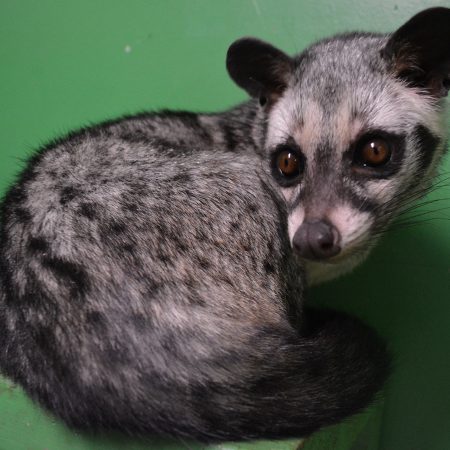Palm Civet
Paradoxurus hermaphroditus
The Palm Civet is native to South and Southeast Asia. It has a broad range of habitats with large populations widely spread out. The Palm Civet can be physically described as having a long, stocky body covered with coarse, shaggy hair. Their fur is usually greyish in color, it has a white mask across the forehead and a small white patch under each eye. The muzzle, ears, lower legs, and tail are black. It’s body is about 21 inches long, not including its 19 inch tail. Palm Civets weigh between 5 to 10 pounds.
Palm Civets are thought to lead a solitary lifestyle, except for brief periods during mating season. They are both terrestrial and arboreal, meaning they can be found scavenging on the ground or in the trees! They are nocturnal animals, coming out in the evenings to forage for food. Palm Civets are omnivores, they eat chiku, mango, rambutan, small mammals, and insects. When threatened this animal will use anal scent glands to emit a nauseating secretion as a chemical defense. Scent marking behavior has been observed in both males and females marking their territories.
While these animals are not endangered, it doesn’t mean they aren’t threatened by predators. Hunting by humans and habitat loss threaten these animals. They have been hunted for bushmeat, pet trade, and a special oil extracted from parts of the meat used for medicine. Kopi Luwak is a coffee prepared using coffee beans that have been fermented in the gastrointestinal tract of the Palm Civet. Palm Civets are increasingly being captured from the wild and fed coffee beans to mass-produce this coffee. There have been conservation efforts put in place to limit the amount of Civets entered into the pet trade.
Say Hello To Cub Creek's Palm Civet: Cashmere
Cashmere was born in November of 2013, and came to live here at camp in May of 2015. She is one of our more solitary animals with a protected personal space bubble. She is nocturnal and only wakes during the afternoon to be fed. Her favorite food is bananas, followed closely by blueberries and sausages.

Palm Civets are native to South and South East Asia. Ranging from India to the Philippine Islands.
HABITAT -They inhabit the canopies and forests of South and SouthEast Asia.
DIET -They are omnivorous, eating fruits, insects, and small mammals.
FUN FACT -The Palm Civet is used in the production of a special coffee called Kopi Luwak.
SOCIAL BEHAVIOR -They typically live a solitary life other than during mating periods.
ACTIVITY -They are mainly nocturnal, being most active during the evening and sleeping during the day.
PREDATORS -Predators include tigers, leopards, large snakes, crocodiles, and humans.
SIZE -They average 21 inches long, not including its 19 inch tail, weighing between 5 to 10 pounds.
RELATIVES -They are related to a variety of other Civet species as well as the common genet.
CONSERVATION -The Palm Civet is categorized as LC (Least Concern) species by the IUCN.
Cub Creek Animal Care Information
Housing - Our Palm Civet lives in a large specialized enclosure, all by themselves to help accommodate their solitary lifestyle. Within their enclosure she has various tree branches on the walls and hanging from the ceiling, she loves climbing all around! The ground of the enclosure is bedded with shavings. There is also a large hide space within the tree branches and a large window for natural sunlight.
Diet - Just like in the wild, their diet consists of mainly fruit! They love a good mixture of apples and bananas, with other fruits, or the occasional mango or other sweet fruit. Their diet is supplemented with foods that meet the high-protein, high energy needs. This can include things like insects, sweet potatoes, sausage, eggs, and greens.
Enrichment - We provide our Palm Civet with plenty of enrichment to keep them stimulated and healthy. When they were younger they began getting accustomed to human interaction, leaping onto shoulders being quite docile in nature. This stems from continual enrichment with toys and social interaction. During the summer, campers will make all kinds of toys for them, made out of cardboard and other materials!

